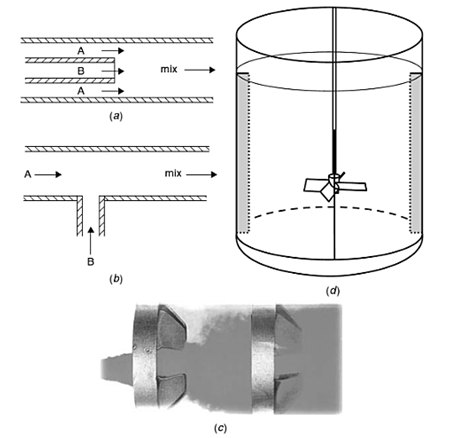There are many reactor geometries used in the chemical industry, but discussion will be limited to four geometries: pipeline, Tee mixer, static mixer, and stirred tank as shown in Figure 4. Additionally, the effect of feed point location will be discussed.

Figure 4. Various mixing geometries used for chemical reactors: (a) co-axial jet pipeline mixer, (b) Tee mixer, (c) static mixer, and (d) stirred tank [3].
A pipe, or tubular reactor, is the simplest chemical reactor. Reactants are injected in one end and allowed to mix as they flow towards the outlet. Often injection is done with a co-axial jet in the center of the pipe. Turbulent flow requires approximately 50 to 100 pipe diameters to achieve 95% uniformity within the pipeline [3]. This option is often used successfully in highly turbulent flow where mixing length and time are not important.
The Tee Mixer is a variation of the pipe mixer where one of the reactants is injected as a side stream jet into the flow of the other reactant. This promotes rapid mixing within the turbulent core of the pipeline. A Tee mixer can shorten the blending to 95% uniformity to between three and five pipe diameters. It is important to design a Tee mixer with the proper jet to pipe velocity and diameter ratios to promote optimal mixing. This option is used when short mixing distances are required and the additive is available at adequate pressure energy.
Static mixers are placed within pipes to divert the internal flow by creating obstructions that promote mixing. Static mixers are the most versatile motionless mixer and have a wide variety of designs and applications. The most economical type of static mixer chosen depends primarily on the flow regime of the system, the viscosity ratio of the feeds to the mixer and the ratio of feed flow rates. Static mixers are ideal for laminar mixing, but also work well in turbulent flow for both single and multiphase flows [3].
The stirred tank consists of a vessel and mixing device. They have a wide variety of uses due to their great operating flexibility. Stirred tanks can be operated in both laminar and highly turbulent mixing regimes, and come in a wide selection of sizes. They can be used for a liquid phase mixture, a liquid-gas mixture, a liquid with suspended solids mixture or a three phase mixture. Precipitation, polymerization and hydrometallurgical processes are usually conducted in stirred vessels [2] Important design criteria for a stirred vessel include impeller type, size and speed and baffle design.
Along with reactor geometry, the position of the feed point can also affect reaction yield and selectivity because there can be a wide range of turbulent length scales and intensities within a reactor. Generally, the ideal location for a feed point to promote rapid blending is in the region with the shortest local mixing time constant or the most intense turbulence [3]. For example, in a stirred tank, optimal mixing occurs if feed is injected close to the tip of the impeller. Multiple injections points are another option to consider if the rate of injection is important. By increasing the number of feed points, the feed flow rate can be decreased without decreasing productivity [2].
|
联系我们
全国服务热线 肇庆一分厂:广东省肇庆高新区(大旺)康泰街3号 肇庆二分厂:广东省肇庆高新区(大旺)建设路36号 E-mail: jinzong@jinzong.com.cn
|


